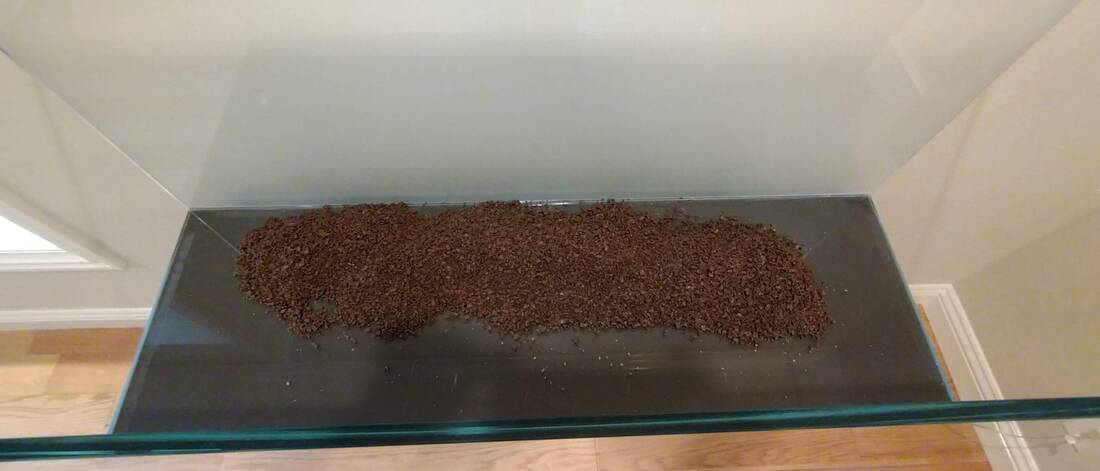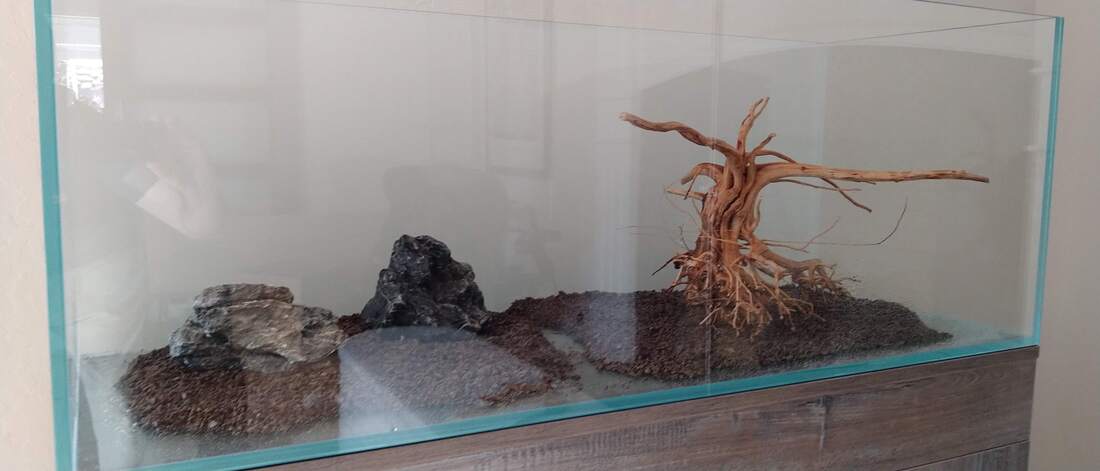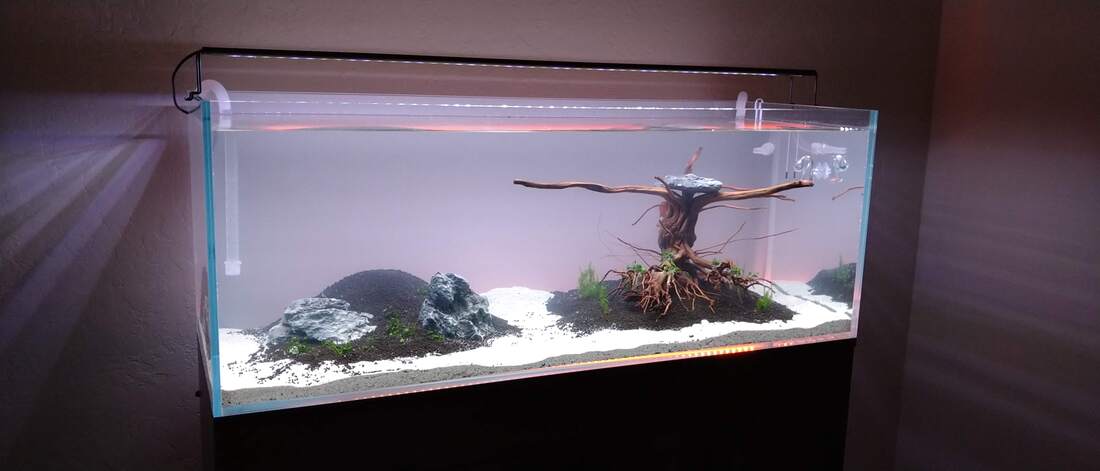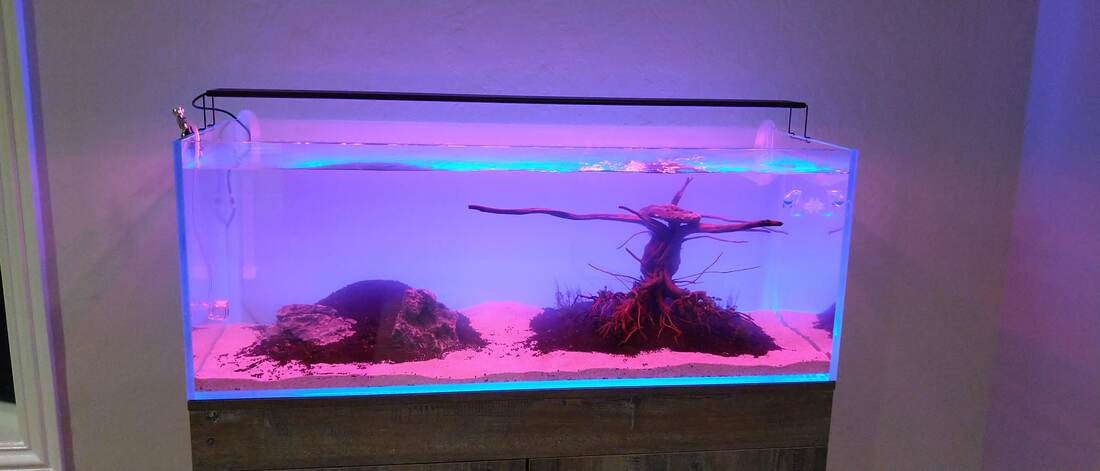|
So I picked out my tank setup and paid some folks to help carry it in place, just plop in some water and add fish! Bye! Not quite. You actually can do that with certain kinds of fish. Some of them are notorious for digging up plants and hardscape, so some folks just forgo the substrate (fancy term for bottom stuff like gravel or sand). Seriously. It's a legit approach to take for certain fish. Setup filter, add water, dechlorinate, add starter bacteria, and add fish the same day. I know a bunch of fish nerds are screaming about cycles right now, but that's not something you need to worry about with a substrate-less approach. That said, I'm using a substrate. I'll be setting up a planted tank so I need something to keep the bottom plants in place. I could go with floating only plants (again a legit thing!), but my fishies will want something nice on the bottom. That and I planned on adding shrimp. For my substrate base layer, I went with the Seachem Flourite Dark. I could have gone with any of the colors since it's underneath everything and will never be seen. But I went with dark because I have other plans on the horizon... I added some Flourite to the bottom, took this picture, then started spraying it with water from a pump sprayer. Nothing fancy, just a basic hand pump sprayer to water things and keep from drying out. A lot of these new "soils" and substrates are active and have beneficial organisms in them. If they dry out, you're wasting money. So use a sprayer to keep things wet. I added more Flourite then started to play around with the various bits of rock and wood I had. It's best to tinker around a bit with stuff now rather than later. For example, I took a handtool saw to some branches of the wood in order to fit better. It fit OK at first, but I trimmed things back so I could get scrubbers and pads in between the glass and wood. Gotta think ahead about cleaning and maintenance. Getting it right the first time pays off. For certain things like larger rocks or stones, you might want to put them directly on the aquarium bottom. Or maybe on a rubber pad if you're worried about scratching the bottom of the glass....yeah whatever. It makes sense to not bother putting expensive substrates underneath...a rock. That and fish/shrimp will always like to rearrange things for you. Putting that rock on the bottom reduces that. The next steps I added Aquasolum on top of the Flourite and ADA La Plata sand at the edges and in between my two islands. Aquasolum is a great soil substrate to work with for keeping plants in place. It's much softer than the Flourite; helpful for shrimp and corydoras catfish! The sand at the edges was...eh I dunno. I'm just going for a tropical isle look. Maybe it's a mistake, but I didn't want to see Flourite and soil right at the edges of the tank. Thought some sand would help mellow it out a bit. I didn't take many pictures during this part of the process. Remy was starting to get antsy and not very helpful. He's not quite at the point where he could take pictures yet, so I just plowed ahead. With a setup like this, you can't just dump water in and expect it to stay in place. Put down paper towels in the tank, then add a small saucer or plate on top of it. Next slowly add the water by splashing it down to the saucer. Doing this helps keep things in place. Speaking of keeping things in place, you'll probably need to weigh down any woods with a stone if you don't want them floating away. It takes a few days for it to get water logged and stay in place. If you go with something like moor wood, soak it weeks in advance if possible. Woods like this will (inevitably) harbor some fungus that starts growing after a week or so. It's harmless white jelly slime, it just looks bad. Pre-soak for two weeks and clean it off outside. Pre-soaking also helps reduce the amount of tannins leeched into the water(if you're trying to avoid that -- some folks want the tannins). Speaking of soaking. do not pre-rinse active soils! You should only pre-rinse inert substrates like sand! (and for sand you really really really should) Things like Flourite and Aquasoil have beneficial goodies that are washed away by rinsing. I've laughed reading various forums as people bad-mouth these products ("I had to rinse it for half an hour before the color went out!"). They're washing away what you pay extra for. As for the "aqua scape", I went with two islands. The left one has a mound sloping rear to front with a few rocks around. The right island is dominated by this great piece of wood I picked up at a local fish store (Albany Aquarium). There's a bad attempt at a stream in between. We'll see how long the stream lasts. I planted some Marsilea Hirsuta for carpeting on the left island. My plan was to add one or two large plants up on the mound to dominate and take focus there. On the right island, I planted some Rotala sp Bangladesh around the tree and Anubias Barteri var nana petite on the tree roots. I used superglue to adhere the Anubias to the roots. It's a thing; people do it. It's safe and inert, and about the only bad thing is that it dries white. If you use too much, it will stick out until your plants grow over it (and Anubias are slow growing plants). All of these plants were lab grown plants bought in cups from Aqua Forest Aquarium in San Francisco. You can buy plants from LFS, but they run the risk of harboring pests like snails (or snail eggs). Some plants you can buy at bigbox stores like Home Depot. I went the lab route to start off on the right foot. It's more expensive, but it seems worthwhile when starting. I used this kit from Marine Depot for the basic aquascaping tools. Nothing fancy but they are well made. Some of this shit is ridiculously overpriced (ADA) and you'll pay $150 for a damn tiny spatula. I know why it exists and who buys it; I'm just not that person. I filled the tank with a little bit of water, then started to plant the Marsilea and Rotala using the tweezers. In hindsight, I should have bought more Marsilea as it propagates and spreads slowly. The Rotala is a weed and grows like one. As mentioned before, I superglued the Anubias to the tree roots. I didn't initially go wild with plants because: a) I feared everything would die b) I wanted to actually grow some things and watch it spread rather than just buy everything on day one. It sat this way for about a week as I waited for all the plants to die...but they didn't! To my surprise, things stayed alive and well. No fish or shrimp at this point, as I waited for some of the starter bacteria to take hold in my filters. Use the starter bacteria. It's good now. It works.
If you look at the two previous pictures, you'll see some changes. I'll talk about those in the next post... Comments are closed.
|
AuthorA NOLA native just trying to get by. I live in San Francisco and work as a digital plumber for the joint that runs this thing. (Square/Weebly) Thoughts are mine, not my company's. Archives
May 2021
Categories
All
|





 RSS Feed
RSS Feed